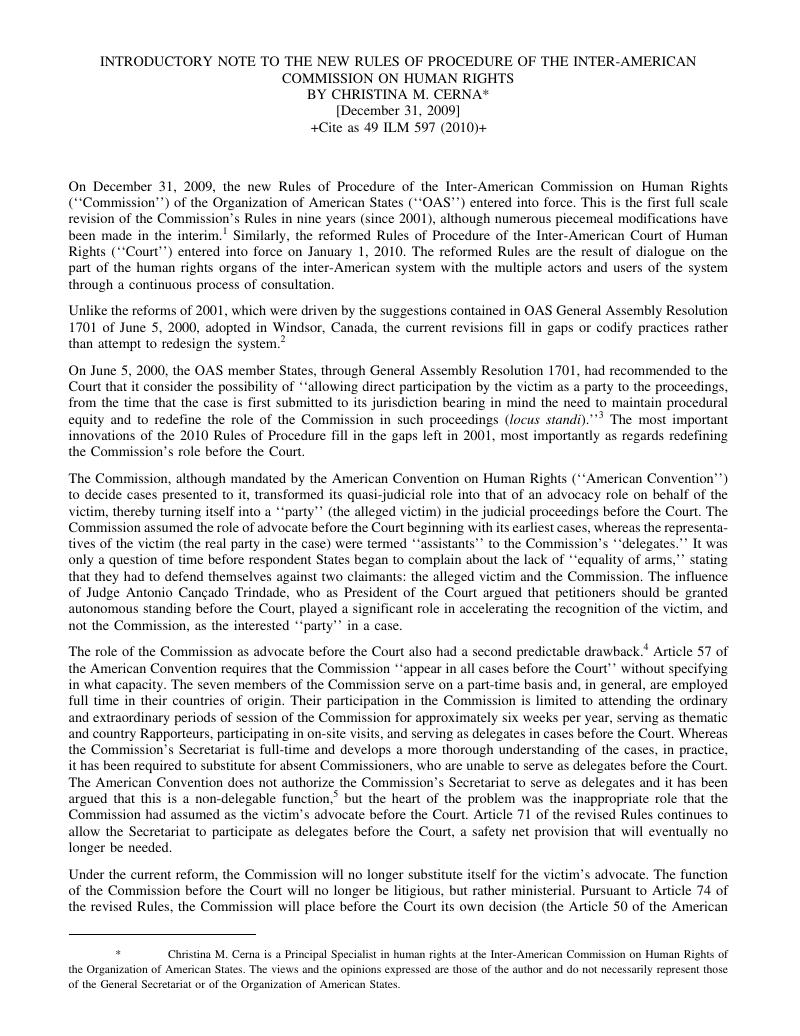No CrossRef data available.
Published online by Cambridge University Press: 27 February 2017

Christina M. Cerna is a Principal Specialist in human rights at the Inter-American Commission on Human Rights of the Organization of American States. The views and the opinions expressed are those of the author and do not necessarily represent those of the General Secretariat or of the Organization of American States.
* This text was reproduced and reformatted from the text available at Center for Justice and International Law official website (visited March 29, 2010) http://cejil.org/en/instrumentos/reglamento-de-la-comision-interamericana-de-derechos-humanos-cidh-2010.
1 See Christina M., Cerna, the New Rules of Procedure of the Inter-American Commission on Human Rights, 40 I.L.M. 748 (2001).Google Scholar
2 OAS G.A. Res. 1701, AG/RES. 1701 (XXX-O/00) (June 5, 2000), reprinted in Inter-Am. C.H.R. No 1, at 25 (2001).
3 Article 23 of the Court’s 2001 Rules gave the victims, their next of kin, or their duly accredited representatives autonomy in the presentation of their “pleadings, motions and evidence throughout the proceedings.” Under the previous Court Rules, the victim, the relatives of the victim, or the victim’s representatives were inappropriately designated the “assistants” of the Commission in the proceedings, when, in fact, they were the interested “party.” Prior to these 2001 modifications, the representatives of the victims could only present their own positions as regards the reparations they sought pursuant to a 1997 modification in the Rules, which was the first step to autonomy from the Commission.
4 For a more extensive discussion of these issues, see Christina M. Cerna, Are We Headed in the Right Direction? Reflections on the New (2001) Rules of Procedure of the Inter-American Commission on Human Rights in Light of the Experience of the European System, in Human Rights and Refugees, Internally Displaced Persons and Migrant Workers: Essays in Memory of Joan Fitzpatrick and Arthur Helton (Anne F. Bayefsky ed., 2006).
5 Id.
6 The revised Rules will put an end to the Secretariat’s former practice of producing an “application” separate from the Article 50 merits report approved by the Commission. The introduction of new violations and legal arguments in the application only served to aggravate respondent States that had to respond to the merits report, the application, and the pleadings of the victim’s representatives. For a longer discussion of this issue, see Cerna, supra note 4.
7 See Statute of the Inter-American Commission on Human Rights art. 8, Oct. 1, 1979, O.A.S. Res. 447 (IX-0/79), OEA/Ser.L/V/II 50, doc.13 rev. 1, at 10 (1980), reprinted in Basic Documents Pertaining to Human Rights in the Inter-American System, OEA/Ser.L.V/II.82, doc.6 rev.1, at 93 (1992).
8 In the European system, the European Court of Human Rights published the European Commission’s merits reports as an appendix to its judgment. Regrettably, this practice was never imitated by the Inter-American Court, and the Inter-American Commission also failed to publish its merits reports.